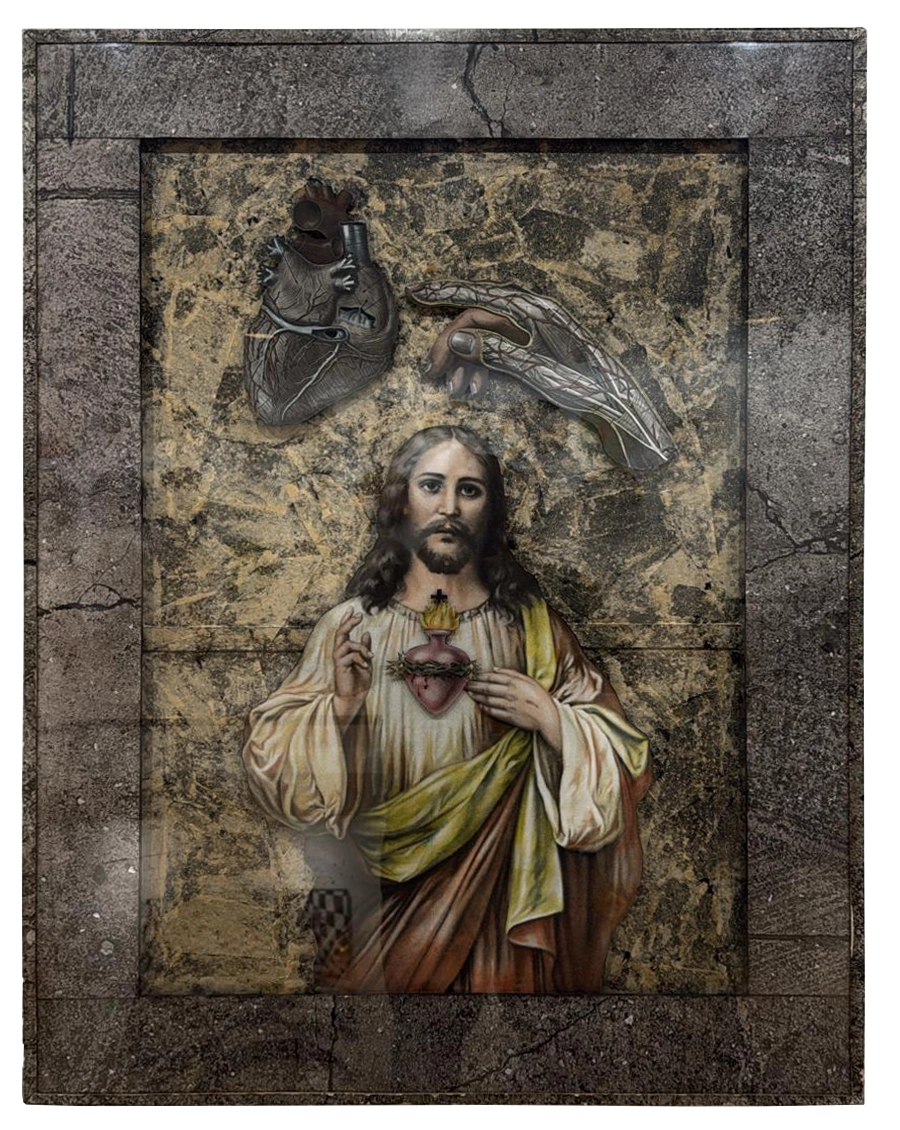


The representation of the Sacred Heart of Jesus finds its roots in seventeenth-century Christian spirituality, though its symbolism reaches much further back—to the medieval devotion to the suffering humanity of Christ. The heart is conceived as the center of Jesus’s divine and human love, a symbol of his total self-giving and infinite compassion toward humankind. Encircled by a crown of thorns, crowned with a cross, and burning with flames, this heart expresses both redemptive pain and loving passion. Its iconography was consolidated through the visions of Saint Margaret Mary Alacoque in France, who spread the devotion to the Heart of Jesus as a sign of reparation and consolation for the sins of the world.
Over the years—many of them—the Sacred Heart became an emblem of faith, sacrifice, and merciful love, charged with a potent theological and political significance. The Catholic Church promoted it as a spiritual response to the rationalism and secularism of modernity. In sacred art, it sought first to inspire devotion, and then to remind believers of the union between physical suffering and transcendent love. The visible, wounded heart stands as a substantive metaphor for the Christian mystery of incarnation: God loves through his suffering humanity.
In 2015, Rubén Torres-Llorca entered a period of creative maturity within his conceptual trajectory. Much of his work was built upon the critical appropriation of iconic images and popular narratives—a recurring device in his poetic practice to reflect on the construction of identity and cultural memory. Based in Miami, Torres-Llorca presented that year his solo exhibition Better Days Ahead at Juan Ruiz Gallery, combining objects, collages, intervened paintings, and pseudo-documentary texts that explored the tension between hope and disillusion, between promise and social failure. These works extended his habitual play between irony and melancholy, where the religious, the political, and the sentimental intersect within a single aesthetic plane.
At the same time, he participated in several group shows that consolidated his presence within Miami’s art scene—Making Circles in the Water, Aesthetics & Values 2015 at the Frost Art Museum, and A Russian, A Chinese and a Cuban, Walk Into an Art Show at the Aluna Art Foundation—where his work entered into dialogue with other artists around mass culture, ideology, and globalization. In these projects, Torres-Llorca sustained his interest in the visual narrative as a structural device—closer to cinema or literature than to traditional painting—and in the friction between the personal and the historical. His 2015 production may be read as a visual essay on Latin American postmodernity: a meditation on faith, exile, and memory within a world saturated by images and unfinished stories.
This piece—created in 2015 and presented here—reinterprets the iconography of the Sacred Heart of Jesus through a contemporary, ironic, and perhaps even sardonic lens. It combines mixed media—photography, digital collage, and assemblage—within a frontal composition that evokes the traditional religious altarpiece. The worn, stony background introduces both distance and doubt; the contrast between the anatomical heart, the mechanical hand, and the sacred figure generates a tension between faith, science, and artifice, exposing the loss—or transformation—of spiritual aura in modern culture. Its style belongs squarely to Torres-Llorca’s postmodern conceptual language: an appropriation of devotional symbols to revisit memory, belief, and Latin American iconography through exile and irony.
Here it come that heavy love, 2015
Mixed media, Acrylic on Canvas | 40 x 30 in
On view at the Winter Selection, MoCA Americas, Kendall, Miami
Monday to Friday, 9 a.m. to 5 p.m.
12063 SW 121st Ave., Kendall, Miami, FL



